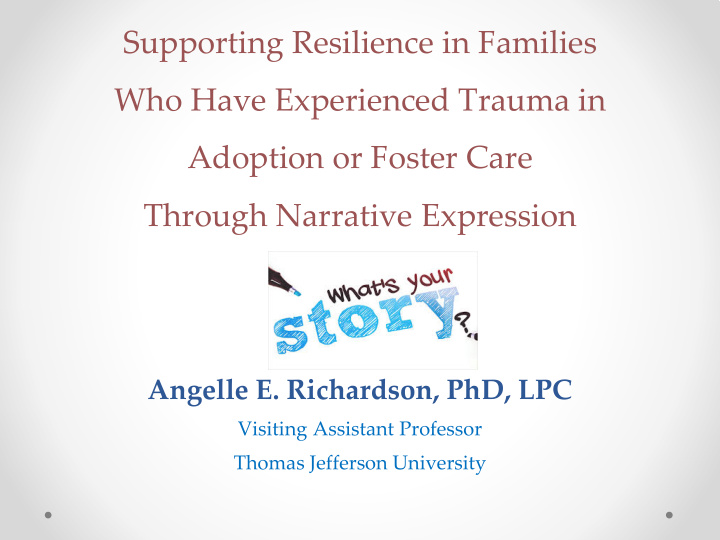



Supporting Resilience in Families Who Have Experienced Trauma in Adoption or Foster Care Through Narrative Expression Angelle E. Richardson, PhD, LPC Visiting Assistant Professor Thomas Jefferson University
Objectives/Overview • Discuss traumas and losses adoptees and children in foster care experience • Examine Narrative Identity and Narrative Identity Theory • Explore two artist who use narratives as a way of healing • Identify techniques to use with individuals or families that have experienced adoption and/or foster care
Trauma in Foster Care and Adoption
Foster Care • There are approximately 428,000 children in foster care at any time according to the National Children’s Alliance. • In 2015 over 670,000 spent time in foster care • The average length of stay in foster care is two years • In 2015 62,000 were waiting to be adopted as a result of their parents parental rights being terminated
Adoption • Approximately 135,000 children are adopted each year in the Unites States • Approximately 59% of these adoptions are from the child welfare system • 15% are voluntarily relinquished babies • 26% are from other countries
Adopted and fostered children experience trauma and multiple losses, no matter what age they were adopted or fostered.
Primary Losses Family Home Friends Pets
Secondary Losses o Familiar smells, tastes and sounds o Loss of clothes o Changes in routine o Changes in schools o Changes in friendships o Being comfortable with their lives
Intangible Loss Safety Security Control Hope
Ambiguous Loss Person is physically absent, but psychologically present. The birth parent(s) is thought about often and psychologically present in the mind of the adopted/foster child
Attachment • Attachment theory posits that secure attachments in infancy predict positive relationships in life. • Bowlby described “attachment bond” as the “warm, continuous… relationship...” created between a parent and child. • Close emotional bond between two people.
Challenges for Adopted and Fostered Children • Adoptive and foster parents often view adoption and foster care differently than the child • Adoptive parents often see the children’s life as “starting” with them • Adoptees and foster youth encounter language challenges around relationships • Lost or fractured relationships are not socially recognized and are often hidden from others • Adoptees and foster youth may feel the need to be perfect/test boundaries • Grief is often overlooked and not discussed in foster care or adoption • Medical history may be unknown or incomplete
Narrative Expression
Narrative Identity • “Narrative identity is the internal and evolving story of the self that one constructs to make sense and meaning out of [their] life.” • Individuals start organizing their lives into narrative identities in their teens and young adulthood, however the process of developing narrative identities continues throughout life. • “In constructing self-defining life stories, people draw heavily on prevailing cultural norms and the images, metaphors, and themes that run through the many narratives they encounter in social life.” -McAdams, 2011
Narrative Identity Theory • Narrative Identify Theory posits that how people tell their stories may predict particular outcomes, including quality of life • When children are able to hear and tell their stories, it gives them resources (resilience)
Expressive Arts • Studies show art in any form can relieve stress • Many cultures use artistic expression as a way of healing
Contemporaries Who Have Used Narrative Expression for Healing
Yrsa Daley-Ward • Jamaican and Nigerian, raised in England by her grandparents • Actress, model, and poet • Struggled with depression, anxiety, suicidal ideation and addiction • Attending a poetry reading in South African inspired her to begin writing poetry herself • Published two books of poetry (On Snakes and Other Stories and Bone) and memoir (The Terrible).
Alexandra (Alex) Elle • African American, experienced emotional and physical abuse as a child • Writer, poet, storyteller, and wellness coach • Hx of suicidal ideation and depression • Began writing as a preteen as a way to heal • Attended therapy and earned to use her words in a constructive way • Believes that sharing stories builds communities and takes away shame • Believes that sharing stories builds resilience • Published two books of poetry (Neon Soul and Love in My Language), a book of affirmations (Words from a Wanderer), and two meditation journals. She also has a podcast (Hey Girl).
-Alex Elle
Techniques for Engaging Children and Families in Narrative Expression
Poetry and Journaling
Story Boards
Cartoon Strips
Illustrative Narration
Our Lives In Music
References Brazile, L. (2018). A growing body of evidence points to the mental health benefits of oral storytelling. YES. Oct, 2018. Castello, M. (2012). How trauma is carried across generations: Holding the secret history of our ancestors. Psychology Today. (May) Cohen, J, Mannarino, A. & Deblinger, E. (2006). Treating Trauma and Traumatic Grief in Children and Adolescents. New York, NY: Guildford Press. Daley-Ward, Y (2014). Bone . CreateSpace Independent Platform. Dwyer, K. (2019). How creating art can help reduce stress. Refinery29. Jan, 2019. Elle, A. (2017). Works retrieved from @alex_elle Elle, A. (2017). Hope, Fertility and Storytelling. Retrieved from https://expectful.com/podcast/hope-fertility-storytelling-alex-elle/ McAdams D.P. (2011) Narrative Identity. In: Schwartz S., Luyckx K., Vignoles V. (eds) Handbook of Identity Theory and Research. Springer, New York, NY Richardson, A., Davey, M., & Swint, P. (2013). Female Adoptees’ Experiences Balancing Relationships with Biological and Adoptive Mothers Post-Reunification. Journal of Marital and Family Therapy , 39, 358-372. Waheed, N. (2013). Salt. CreateSpace Independent Platform. Wolfelt, A. (2004). Understanding Your Grief. Companion Press.
Recommend
More recommend